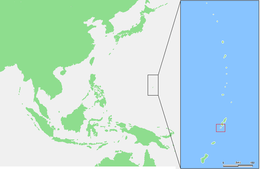Aguijan
 |
|
 |
|
| Geography | |
|---|---|
| Location | Pacific Ocean |
| Coordinates | 14°51′13″N 145°33′34″E / 14.85361°N 145.55944°E |
| Archipelago | Northern Mariana Islands |
| Area | 7.09 km2 (2.74 sq mi) |
| Length | 4.7 km (2.92 mi) |
| Width | 1.8 km (1.12 mi) |
| Highest elevation | 157 m (515 ft) |
| Administration | |
|
United States
|
|
| Commonwealth | Northern Mariana Islands |
| Demographics | |
| Population | - uninhabited - (2010) |
Aguigan (also known as Aguihan, based on the Spanish rendition of the native name, "Aguijan", which is still often used as well) is a small bean-shaped coralline island in the Northern Mariana Islands chain in the Pacific Ocean. It is situated 8 kilometers (5.0 mi) southwest of Tinian, from which it is separated by the Tinian Channel. Aguigan and neighboring Tinian Island together form Tinian Municipality, one of the four main political divisions that comprise the Northern Marianas.
Aguigan is only 7.09 square kilometers (2.74 sq mi) in size, with a length of 4.7 km (2.9 mi) and a width of 1.8 km (1.1 mi). It is nicknamed “Goat Island” due to the large number of feral goats present there. Much of the native vegetation on Aguigan has been destroyed by goats.
Aguigan is uninhabited and is seldom visited because it is surrounded by sheer steep cliffs. However, a 2002 survey of the island did find a handful of native species there, including the Mariana fruit bat, the Polynesian sheath-tailed bat and the Micronesian megapode Megapodius laperouse.
It is likely that first sighting by Europeans occurred during the Spanish expedition of Ferdinand Magellan, or by its continuation by Gonzalo Gómez de Espinosa being charted as Santo Ángel. It was visited by the Spanish missionary Diego Luis de San Vitores in 1669.
Aguigan was administered as part of the Spanish Mariana Islands from the 16th century to 1899, when the Northern Marianas were sold by Spain to the German Empire. Under Germany, it administered as part of German New Guinea. During World War I, Aguigan came under the control of the Empire of Japan and was administered as part of the South Pacific Mandate. During World War II, the Imperial Japanese Army maintained a garrison on Aguigan. This garrison is noteworthy because of its surrender to Allied forces September 4, 1945, two days after the surrender of Japan on the USS Missouri (BB-63). The surrender is unique because it was the only surrender hosted by a U.S. Coast Guard Cutter, USCG 83525. US Navy Admiral Marshall R. Greer received the surrender of the Japanese Second Lieutenant Kinichi Yamada.
...
Wikipedia
